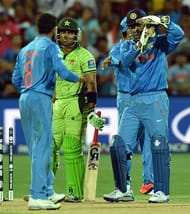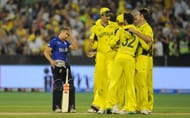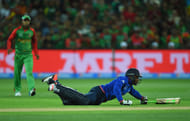The 2015 World Cup has seen some memorable performances so far with both bat and ball. Chris Gayle being the first man to slam a double hundred in the history of the tournament, AB de Villiers smashing the fastest 150 in the history of ODI cricket, Tim Southee recording the best figures by a New Zealand fast bowler by taking 7 wickets for 33 against England, and so on.As much exciting as the on-field action has been, there have been certain instances where the umpires have also come under the spotlight with regards to certain decisions that they have made.Here are 5 of the most controversial umpiring decisions seen so far:
#5 Umar Akmal gets a feather

After India had posted a competitive 300 for 8 in their 50 overs, Pakistan found themselves in a little bit of a trouble at 103 for 4 after Umesh Yadav had picked up Ahmad Shahzad and Sohaib Maqsood in the same over.
Umar Akmal was the new man in for Pakistan and off the fourth delivery that he faced off Ravindra Jadeja, the ball beat his outside edge. On taking the catch, Dhoni went up immediately for a caught behind appeal. Umpire Richard Kettleborough didn't seem convinced that Akmal had nicked it and ruled it not out.
The Indian skipper didn't agree with the decision and went for the Decision Review System(DRS). The replays indicated that the ball seemed to have changed its path as it went past the bat, but crucially the Snicko didn't show any big spike as is the case when the ball hits the blade.
After having a discussion with the TV umpire, Kettleborough had to reverse his earlier decision andrule Akmal out, thereby sparking off celebrations in the Indian camp.
The wicket proved to be important for the Men in Blue as a quickfire knock from Akmal might have altered the momentum in Pakistan’s favour. They eventually went on to win the game by 76 runs and maintain their unbeaten streak against their arch-rivals at the mega event.
#4 Were Michael Clarke and Kumar Sangakkara out?

Australia didn't get off to the best of starts in their Pool A encounter against Sri Lanka, with the opening pair of David Warner and Aaron Finch back in the pavilion with the score at 41. Steven Smith, along with his skipper Michael Clarke, got down their heads to rebuilding the innings.
The duo put on 133 runs for the third wicket before Clarke had his middle stump pegged back by a full ball from Lasith Malinga. The replays though indicated that Malinga’s left foot might have just landed on the line, and since the line belongs to the umpire, it had to be called a no-ball.
After some deliberation, Clarke had to continue to make his way back to the pavilion for 68 as it was felt that there was a miniscule part of Malinga’s foot that had landed behind the line.
In the same game, Kumar Sangakkara who was batting beautifully on 104, was caught on the point boundary by Aaron Finch off James Faulkner. Once again, like in the case of Malinga, it was a touch-and-go situation and it was felt that Faulkner might have had a very little part of his foot behind the line. Since there wasn‘t conclusive evidence to prove that he had gone over, Sangakkara had to go back to the pavilion.
The Sangakkara decision, especially, did peg Sri Lanka a bit and had he stayed in the middle for a few more overs, the Lankans could come a lot closer to the total than they did eventually.
#3 The James Taylor run out

Australia made full use of Eoin Morgan’s decision to win the toss and bowl first, piling up 342 for 9 in their 50 overs in the match between the two traditional rivals. While chasing such a massive total, one of the keys is the top order building a solid foundation, which can then be further strengthened by the middle and the lower orders.
However, they got anything but a good start as none of the top order batsmen could make any substantial contribution. Only James Taylor, batting inexplicably at number 6, could put up a decent score on the board.
The right-hander was approaching his maiden ODI hundred when in the 42nd over of the innings, a full ball by Josh Hazlewood rapped him on his pads. The Australians rightfully appealed and umpire Aleem Dar gave Taylor out. Since his side had a review remaining, Taylor took it with no hesitation.
The replays suggested that the ball wasn't hitting the stumps and it seemed as if Dar had to overturn his call.
However, it came to pass that Glenn Maxwell had broken the stumps down with a direct hit at the non-striker’s end as the two batsman had tried to scamper through for a run. So while Taylor waited for his decision, James Anderson, who was at the other end, was found to be short of his crease and was given out run out.
The rule book states that the minute the on-field umpire gives an ‘out; decision, the ball gets termed dead. Taylor looked to be suggesting this very fact to the umpire as he walked away, dejected to have missed out on his hundred, even as the Australians celebrated a massive 111-run win.
#2 John Mooney\'s catch at boundary

Thanks to a fine century from Ed Joyce and a 97 from Andrew Balbirnie, Ireland posted 331 for 8 in 50 overs in their Pool B encounter against Zimbabwe at Hobart. in reply, the Zimbabweans put up a spirited fight, thanks to a 91-ball 121 for Brendan Taylor. Giving him support was Sean Williams, who kept his side in the game till the very end with some lusty hits following Taylor's dismissal.
The real drama though came in the in the 47th over of the innings, when Williams looked to get to his century with a six off Kevin O’Brien, but was caught inches off the rope on the deep midwicket boundary by John Mooney.
The umpires rightly went to the third umpire to have a closer look at the take by Mooney and replays didn't make matters any easier for the TV umpire as there just didn't seem to be any conclusive evidence on whether or not the fielder’s foot was touching the rope when he had caught the ball.
Williams had a word with Mooney asking him whether he had touched the line and when it was informed to him that the catch had been taken cleanly, he made his way back to the dressing room, even before the final decision was given by the umpire.
He was eventually given out by the TV umpire and that decision proved to be extremely critical in the end, despite the Zimbabwean tail putting up a brave show. They lost the game by 5 runs, and with that all hopes of them making it to the final eight also sank.
The decision led to an uproar in Zimbabwe, the most famous instance being the much-criticised article questioning Mooney’s honesty, and connecting his ethics with his long-term battles with alcoholism and depression.
#1 Was Chris Jordan out?

England took on Bangladesh in a must-win Pool A encounter at the Adelaide Oval on Monday. Chasing a competitive total of 276 runs, The Eoin Morgan-led side were 238 for 7 in the 46th over, still needing 38 runs to win, when Chris Jordan walked in to join Chris Woakes in the middle.
It was the final ball of the over, bowled by Taskin Ahmed. Jordan defended a ball and set off for a run. Woakes refused the single and Jordan had to put in the dive and hope that it saved him, following a direct hit from Shakib Al-Hasan.
The decision was turned over by Billy Bowden to the third umpire. Replays showed that when Jordan put the dive in, the bat was in the air despite him having grounded it. His bat bounced off the ground, and seemed – inconclusively – that it was in the air at the moment when the bails were dislodged from the stumps.
It was as tough a decision as it could get for the third umpire and much to the England’s dismay, Jordan was given out.
The verdict proved to be extremely decisive in the end as they lost the match by 15 runs and that ended all hopes of them making it to the quarter-finals.
Brand-new app in a brand-new avatar! Download CricRocket for fast cricket scores, rocket flicks, super notifications and much more! 🚀☄️
